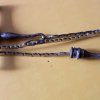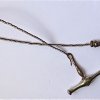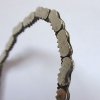 |
| |
After the obstetrician Jean-René SIGAULT (1740-?) Had in 1777 successfully separates the cartilaginous symphysis a patient in order to expand the basin, and De CAMBON had repeated the procedure three times 1778/80, their successors set about not the cartilage, but Sawing the bone - believing that bone heals better than cartilage - and lateral bone resection represents a lower risk of injury to the urethra than the medial section of the symphysiotomy. In 1785, the Scottish surgeon and obstetrician John AITKEN Les deux Extrémités de gave (d. 1790) in his obstetrical work "Principles of Midwifery or puerperal Medicine", a band saw of small toothed platelets to "série de chaînons denticulés et articulée au moyen de goupilles. The instrument sont fixées à un poignée d'ivoire ", with which he could sever the pelvic bones (next to the symphysis). Yes, AITKEN, probably in a fit of mental fogging ("délire" quoted OSIANDER *), wanted to completely excise the bony X, which connects both halves of the pelvis, in order to facilitate future births as well ...
* An allusion to the fact that AITKEN committed suicide in 1790 by severing an arteria femoralis in the presence of two helpless colleagues.
His compatriot James JEFFRAY (1759-1848) claimed to be the actual inventor of the chainsaw, but only in 1790 had a saw of its own design. The JEFFRAY chainsaw, like that of AITKEN, consisted of individual links connected by cylinder joints.
"Dans quelques cas de nécrose ou de caries partial à la main ou au pied, par exemple aux os you métacarpe et du métatarse, il est important d'all séparer la partie malade, au milieu des tissus voisins que la maladie n'a pas encore atteints; mais il est évident que les scies dont nous avons parlé Jusqu'ici seraient d'un emploi tout-à-fait impossible C'est dans le but de répondre à cette difficulté que Jeffray a eu le premier de l'idée. la scie à chainette, dont on ne saurait trop l'louer dans utilité maintes circonstances difficiles. Cette scie consiste en une sorte de chaîne de montre, dont les maillons sont armés de l'un de leurs dents sur overboard, et son ensemble représente une série de petites scies Articulees les unes à la suite des autres. Chaque extrémité de cet instrument est munie d'un petit some transversal, à l'aide duquel il peut être mis en mouvement. Comme on le devine facilement, il est d'une flexibilité extrême "(Dictionnaire de médecine et de surgery pratique, Tome 14, p. 555, Paris 1835).
Karl Kasper SIEBOLD (1736-1807) performed on February 4, 1778, the first pelvic perforation with bone perforation in Germany.
The presented saw has a chain length of 30 cm and handles made of metal (the chromation is mostly exfoliated), so it should have been used after 1900, as older models had handles made of ivory or ebony. Origin of the object: Luzy-sur-Marne in the Champagne-Ardenne region.
Nota: In 1900, the wire saw by GIGLI, which in 1897 was worth a dozen for 3 Reichsmark, was always cheaper (see Gigli saw 2).
Development
In 1830 Bernhard HEINE (1800-1846), a native of the Black Forest and practicing medicine in Würzburg, used the technical principle of the chainsaw, but moved the incisors to the outer edge and ran the inner edge of the chain, which he assembled into an endless chain, over a rail , He sawed bones with this "osteotome". Today it will be felled by tree giants ... which brings us back to the Black Forest!
Lit.:
- Skippen M, Kirkup J, Maxton RM, McDonald SW., The chain saw, a Scottish invention, in: Scott Med J. 2004 May;49(2):72-5.
- Johnson, Robert Scott JD; Sippo, Dorothy A. MD; Swan, Kenneth G. MD, The Flexible Chain Saw During the American Civil War, in: Journal of Trauma-Injury Infection & Critical Care: August 2010 - Volume 69, S. 455-458
- John Kirkup, John Aitken's chain saw, in: J Med Biogr.2009; 17:80
- Mark Skippen, John Kirkup, Ronald M. Maxton, Stuart W. McDonald, The Chain Saw – A Scottish Invention, in: SMJ 2004 49(2): 57-60
|







